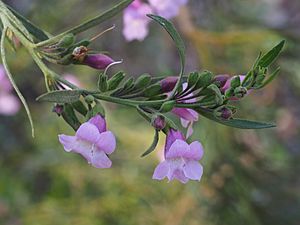Eremophila complanata facts for kids
Quick facts for kids Eremophila complanata |
|
|---|---|
 |
|
| E. complanata leaves and flowers | |
| Conservation status | |
| Scientific classification | |
| Genus: |
Eremophila (plant)
|
| Species: |
complanata
|
Eremophila complanata is a beautiful flowering plant that belongs to the figwort family, called Scrophulariaceae. This plant is special because it grows naturally only in a small part of Western Australia. It's an upright bush with long, flat leaves and pretty pink flowers that also look a bit flattened.
Contents
About the Plant
Eremophila complanata is an upright, somewhat delicate bush. It usually grows to about 2 metres (6.6 ft) tall and 1 metre (3.3 ft) wide. Its branches feel a bit sticky because they have a natural resin on them.
Leaves and Stems
The leaves grow one after another along the branches, not directly opposite each other. They are spread out nicely. Each leaf is long and narrow, shaped like a line or a thin oval. They are usually between 20 and 35 millimetres (0.79 and 1.38 in) long and 1.6 to 3.5 millimetres (0.063 to 0.138 in) wide. These leaves are dark green, shiny, and also a bit sticky.
Flowers and Fruits
The flowers grow in groups of 3 to 6 where the leaves meet the stem. They sit on flat stalks that are 7 to 15 millimetres (0.28 to 0.59 in) long. Each flower has 5 slightly overlapping, egg-shaped, pointed, and hairy green parts called sepals. These sepals are about 3.5 to 5.5 millimetres (0.14 to 0.22 in) long.
The petals are 15 to 18 millimetres (0.59 to 0.71 in) long and are joined together at the bottom to form a tube. The top part of this tube is pink to purple, while the bottom part is white or light pink. The outside of the tube and the petal tips are hairy. However, the inside of the petal tips is smooth, and the inside of the tube is full of long, soft hairs. The 4 stamens, which are the parts that produce pollen, are completely hidden inside the petal tube.
This plant usually flowers from August to September. After the flowers, it produces oval-shaped fruits that are flat and smooth. They are about 4 millimetres (0.16 in) long.
How it Was Named
Eremophila complanata was first officially described by a scientist named Robert Chinnock in 2007. He wrote about it in a book called Eremophila and Allied Genera: A Monograph of the Plant Family Myoporaceae. The first plant specimen used to describe the species was collected by Chinnock himself. He found it in the Chiddarcooping Nature Reserve, which is near a town called Mukinbudin.
The second part of the plant's name, complanata, comes from a Latin word. It means "flattened," which makes sense because the plant has flat leaves and flowers.
Where it Grows
This type of eremophila plant is found in the Chiddarcooping Nature Reserve. This area is part of the Avon Wheatbelt region in Western Australia. It likes to grow in sandy soil, often close to large granite rocks.
Protecting the Plant
The Government of Western Australia's Department of Parks and Wildlife has given Eremophila complanata a special status called "Priority Two." This means that not much is known about the plant, and it grows in only one or a few places. Because of this, it needs to be carefully watched and protected.
Growing it in Gardens
Eremophila complanata is a great choice for gardens. Its shiny leaves and many bright pink flowers in spring make it look very attractive. It's quite easy to grow new plants from cuttings taken from December to March.
This plant can grow in different types of soil and likes a sunny or partly shaded spot. It doesn't need a lot of water once it's established, so it's good for dry areas. It can also handle most frosts. However, strong winds can sometimes damage it, so it's a good idea to plant it among other bushes for protection.
Images for kids
-
E. complanata growing in Kings Park, Perth



